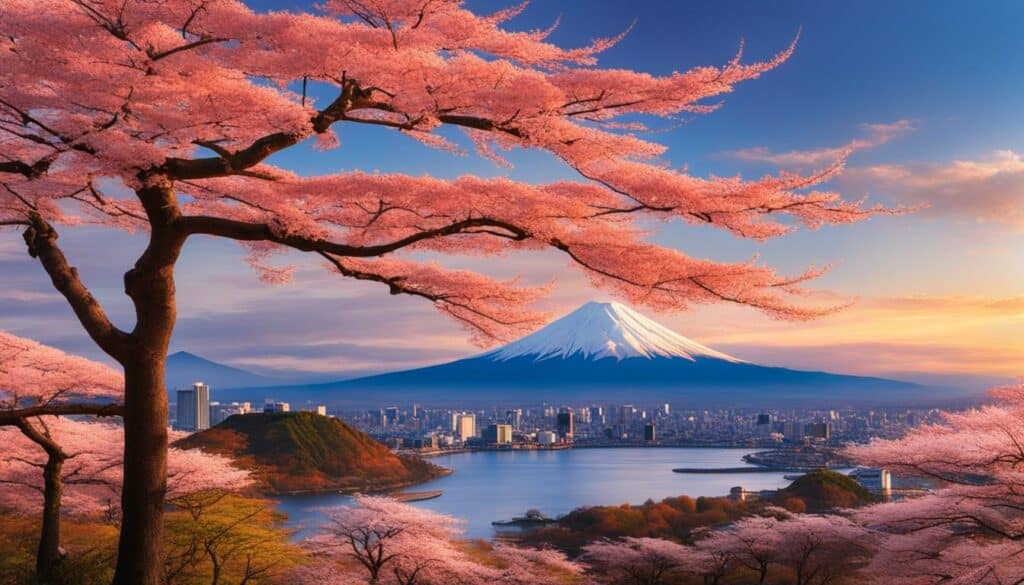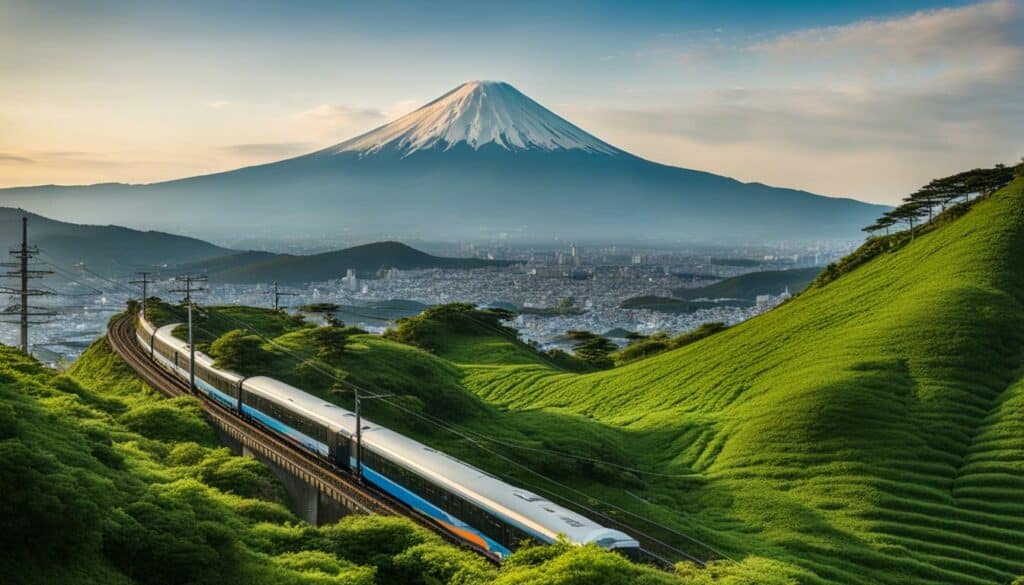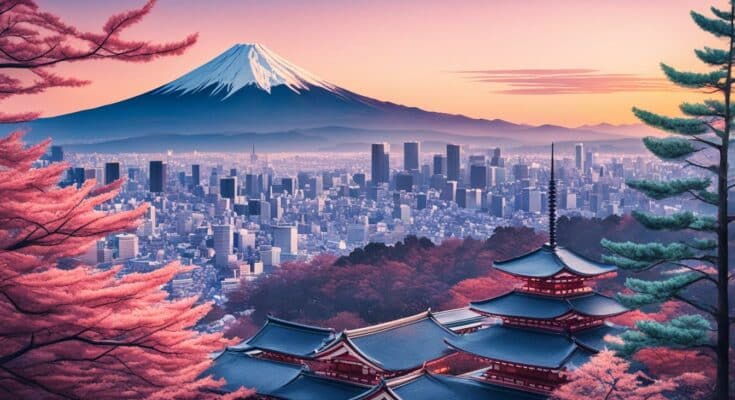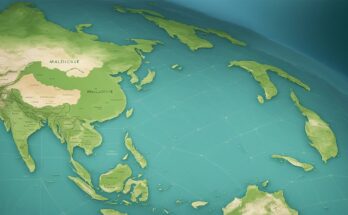Are you planning a trip to Japan and wondering how far it is from Fuji to Tokyo? Look no further! In this article, we will explore the distance between these two iconic destinations and the various modes of transportation available.
Mount Fuji, Japan’s tallest mountain, is located approximately 100 km (60 miles) from central Tokyo. Despite being a separate city, the proximity of Mount Fuji to Tokyo makes it easily accessible for a day trip or a longer exploration. Whether you’re a nature enthusiast, an adventure seeker, or simply seeking cultural enlightenment, Mount Fuji is an experience not to be missed.
So, let’s delve into the details of the distance and travel time options from Tokyo to Mount Fuji!
Key Takeaways:
- The distance between Mount Fuji and central Tokyo is approximately 100 km (60 miles).
- Traveling by direct highway bus or car takes around 2-2.5 hours.
- Trains are another convenient option, with a travel time of about 2-2.5 hours.
- Mount Fuji’s proximity to Tokyo makes it an easily accessible day trip destination.
- Plan your journey and enjoy the scenic beauty of Japan’s iconic mountain!
Why Visit Mount Fuji?
Mount Fuji, standing at a majestic 12,388 ft (3,776 m), is more than just a towering peak; it holds immense cultural and spiritual significance. Revered in Japanese culture for centuries, Mount Fuji has been a sacred destination for pilgrims seeking spiritual purification.
The significance of Mount Fuji goes beyond its spiritual value. Its iconic views and symmetrical cone shape have inspired countless artists, poets, and writers, making it a symbol of beauty and tranquility. From traditional woodblock prints to modern photography, Mount Fuji has been immortalized in various artistic and cultural expressions.
But there’s more to Mount Fuji than its cultural significance. It offers a wide range of outdoor adventures for nature enthusiasts and thrill-seekers alike. Hiking to the summit is a popular challenge, allowing you to experience the breathtaking beauty of the surrounding landscape. Additionally, the area surrounding Mount Fuji is dotted with picturesque lakes, serene waterfalls, and soothing hot springs, inviting exploration and relaxation.
Embarking on an outdoor adventure at Mount Fuji not only allows you to immerse yourself in the natural wonders of Japan but also offers a profound sense of spiritual connection and introspection. The grandeur of the mountain, combined with the tranquil surroundings, provides a perfect setting for self-reflection and rejuvenation.
“Mount Fuji is more than just a mountain; it is a symbol of Japan’s beauty, resilience, and sacredness. Visiting Mount Fuji is an opportunity to witness the harmony between nature, culture, and spirituality.”
Whether you’re seeking a spiritual experience, artistic inspiration, or thrilling outdoor activities, Mount Fuji promises to deliver an unforgettable journey. Its significance is not limited to its physical grandeur, but it encompasses a spiritual and cultural heritage that continues to captivate visitors from around the world.
How Far is Fuji from Tokyo? (Distance and Travel Time)
When planning a visit to Mount Fuji from Tokyo, it’s important to consider the distance and travel time between the two destinations. The proximity of Mount Fuji to Tokyo makes it an ideal day trip option for travelers looking to immerse themselves in the beauty of Japan’s iconic mountain.
The distance between central Tokyo and Mount Fuji is approximately 100 km (60 miles). This moderate distance allows for a convenient and manageable journey, ensuring that visitors can spend more time exploring and less time in transit.
The travel time from Tokyo to Mount Fuji can vary depending on the mode of transportation chosen. Here are the options:
- By Direct Highway Bus: Traveling by direct highway bus offers a comfortable and hassle-free experience. The journey typically takes around 2-2.5 hours, providing ample time to relax and enjoy the scenic views along the way.
- By Train: Trains are another popular choice for traveling from Tokyo to Mount Fuji. The train ride takes approximately 2-2.5 hours, depending on the specific route and train service selected. This option is well-suited for those who prefer the convenience of public transportation.
- By Car: Driving by car is also a viable option, especially for travelers who prefer the flexibility and independence of having their own transportation. The drive from Tokyo to Mount Fuji takes around 1.5-2 hours under normal traffic conditions, offering the opportunity to enjoy a scenic road trip.
No matter which mode of transportation you choose, you can expect a relatively short and pleasant journey from Tokyo to Mount Fuji. The ease of travel allows visitors to maximize their time at the mountain, whether it’s exploring the Fuji Five Lakes area, hiking part of the trail, or simply taking in the breathtaking views.
With Mount Fuji located just a stone’s throw away from Tokyo, embarking on an unforgettable adventure to this iconic landmark is within easy reach.
Best Time to Visit Mount Fuji
When planning your visit to Mount Fuji, it’s important to choose the best time to ensure optimal weather conditions and visibility. The ideal time to see Mount Fuji is during the official climbing season, which typically runs from July to early September. During this period, the trails leading up to the summit and the mountain huts are open for climbers, providing an immersive and memorable experience.
However, if you prefer to avoid the peak climbing season, the months of September to November also offer a good time to visit Mount Fuji. During these months, you can expect cooler temperatures and fewer crowds, allowing you to enjoy the beauty of the mountain in a more tranquil setting.
The autumn foliage in November adds another layer of stunning scenery to the experience, with vibrant colors painting the landscape. This time of year is especially recommended for nature enthusiasts and photographers looking to capture the breathtaking beauty of Mount Fuji surrounded by colorful foliage.
For those who appreciate a winter wonderland, visiting Mount Fuji during the winter season can be a magical experience. The mountain is often covered in snow, presenting a picturesque sight. However, it’s important to note that visibility can be hit or miss during winter due to clouds and storms. Nevertheless, if you’re lucky enough to catch clear skies, the snow-capped views of Mount Fuji are truly awe-inspiring.
Lastly, spring, from March to June, is the cherry blossom season in Japan. While Mount Fuji is not particularly known for its cherry blossoms, the surrounding areas offer beautiful displays of these delicate pink flowers. Keep in mind that rain and low-hanging clouds can sometimes obstruct the views of the mountain during this time, but the cherry blossoms provide a unique and enchanting atmosphere.
Overall, the best time to visit Mount Fuji depends on your preferences and the type of experience you’re seeking. Whether you choose to climb the mountain during the official season, enjoy the autumn foliage, witness the snow-capped peaks in winter, or capture the beauty of cherry blossoms in spring, Mount Fuji offers a mesmerizing backdrop for your journey.
Summary of the Best Times to Visit Mount Fuji:
- July to early September: Official climbing season with optimal weather conditions and accessibility.
- September to November: Cooler temperatures, fewer crowds, and stunning autumn foliage.
- Winter (December to February): Snow-capped views, but be aware of possible cloud cover and storms.
- March to June: Cherry blossom season in surrounding areas, but potential rain and low clouds.
| Season | Highlights | Considerations |
|---|---|---|
| Official Climbing Season (July to early September) | – Optimal weather and visibility – Trails and mountain huts open |
– Higher chance of crowds |
| September to November | – Cooler temperatures – Stunning autumn foliage |
– Less crowded – Possibility of cloudy days |
| Winter (December to February) | – Snow-capped views of Mount Fuji | – Limited visibility due to clouds and storms |
| Spring (March to June) | – Cherry blossom season in surrounding areas | – Possible rain and low clouds obstructing the views |

Transportation Options from Tokyo to Mount Fuji
When it comes to exploring the beauty of Mount Fuji from Tokyo, there are several transportation options to choose from. Whether you prefer a comfortable ride on a bus, the convenience of a train, or the freedom of driving yourself, there’s a transportation option that suits your needs.
Direct Highway Bus
The direct highway bus is the most convenient option for travelers looking to visit Mount Fuji from Tokyo. It offers a hassle-free journey with a travel time of around 2-2.5 hours, depending on traffic conditions. Sit back, relax, and enjoy the scenic views as you make your way to this iconic destination.
Trains
If you’re already exploring Tokyo without a car, trains are a popular and efficient mode of transportation to reach Mount Fuji. With a travel time of about 2-2.5 hours, trains provide a convenient and comfortable journey. Sit back, relax, and immerse yourself in the beauty of Japan’s countryside as you make your way to Mount Fuji.
Renting a Car
For those who prefer the freedom and flexibility of driving themselves, renting a car is a great option. The journey from Tokyo to Mount Fuji takes around 1.5-2 hours under normal traffic conditions, allowing you to enjoy the drive at your own pace. The stunning landscapes along the way make for a memorable road trip experience.
| Transportation Option | Travel Time | Advantages |
|---|---|---|
| Direct Highway Bus | 2-2.5 hours | – Convenient and hassle-free – Scenic views during the journey |
| Trains | 2-2.5 hours | – Popular and efficient – Comfortable and convenient for tourists without a car |
| Renting a Car | 1.5-2 hours | – Freedom and flexibility to explore at your own pace – Enjoyment of a road trip experience |
Each mode of transportation offers its own advantages, allowing you to choose the option that best fits your preferences and travel style. Whichever way you choose to reach Mount Fuji, you’re in for a breathtaking experience.

Conclusion
Mount Fuji’s proximity to Tokyo and its rich cultural, spiritual, and natural significance make it an unmissable destination for travelers. Whether you choose to embark on a challenging hike up the mountain, soak in the panoramic views from the Fuji Five Lakes area, or marvel at the majestic peak from observation decks in Tokyo, Mount Fuji promises a truly awe-inspiring experience.
The best time to visit is during the official climbing season from July to early September when the trails are open and visibility is at its best. However, other months also offer their own unique charm, with stunning views and seasonal attractions. The autumn foliage in September to November and the snow-capped winter views provide captivating scenery, while the cherry blossom season from March to June introduces a touch of delicate beauty.
Getting to Mount Fuji from Tokyo is convenient and hassle-free, with several transportation options available. You can opt for a comfortable and direct journey on a highway bus, enjoy a scenic ride on a train, or explore at your own pace by renting a car. These transportation options ensure that visiting Mount Fuji for a day trip or longer is easily accessible for travelers of all preferences and travel styles. So, plan your journey, soak in the scenic beauty, and create unforgettable memories at Japan’s iconic Mount Fuji.
FAQ
How far is Fuji from Tokyo?
Mount Fuji is located approximately 100 km (60 miles) from central Tokyo.
What is the travel time from Fuji to Tokyo?
The distance between Fuji and Tokyo can be covered in about 2-2.5 hours by direct highway bus or by driving. Trains are another convenient mode of transportation, taking around 2-2.5 hours to reach the Fuji Five Lakes area near Mount Fuji.
Why visit Mount Fuji?
Mount Fuji is not only Japan’s tallest mountain standing at 12,388 ft (3,776 m), but it also holds great cultural and spiritual significance. It is revered in Japanese culture and has been a destination for pilgrims seeking spiritual purification for centuries. Mount Fuji’s iconic views and symmetrical cone shape have made it a subject of much artistic and cultural expression. Additionally, the mountain offers opportunities for outdoor adventure, such as hiking and exploring the surrounding lakes, waterfalls, and hot springs.
What is the best time to visit Mount Fuji?
The best time to visit Mount Fuji and have the optimal weather and visibility is during the official climbing season, which runs from July to early September. However, the months of September to November are also considered a good time to see Mount Fuji, with cooler temperatures and fewer crowds. Winter brings snow-capped views of Mount Fuji, but visibility can be hit or miss due to clouds and storms. Spring, from March to June, is the cherry blossom season, but rain and low clouds can obstruct views of the mountain.
How can I get from Tokyo to Mount Fuji?
There are several transportation options available from Tokyo to Mount Fuji. The most convenient option is the direct highway bus, which takes around 2-2.5 hours, depending on traffic conditions. Trains are also a popular mode of transportation, with a travel time of about 2-2.5 hours. Another option is to rent a car and drive to Mount Fuji, which takes around 1.5-2 hours under normal traffic conditions.
Is Mount Fuji easily accessible from Tokyo?
Yes, Mount Fuji’s proximity to Tokyo makes it an easily accessible day trip destination. The distance between central Tokyo and Mount Fuji is approximately 100 km (60 miles), and there are various transportation options available for visitors to reach the mountain.




